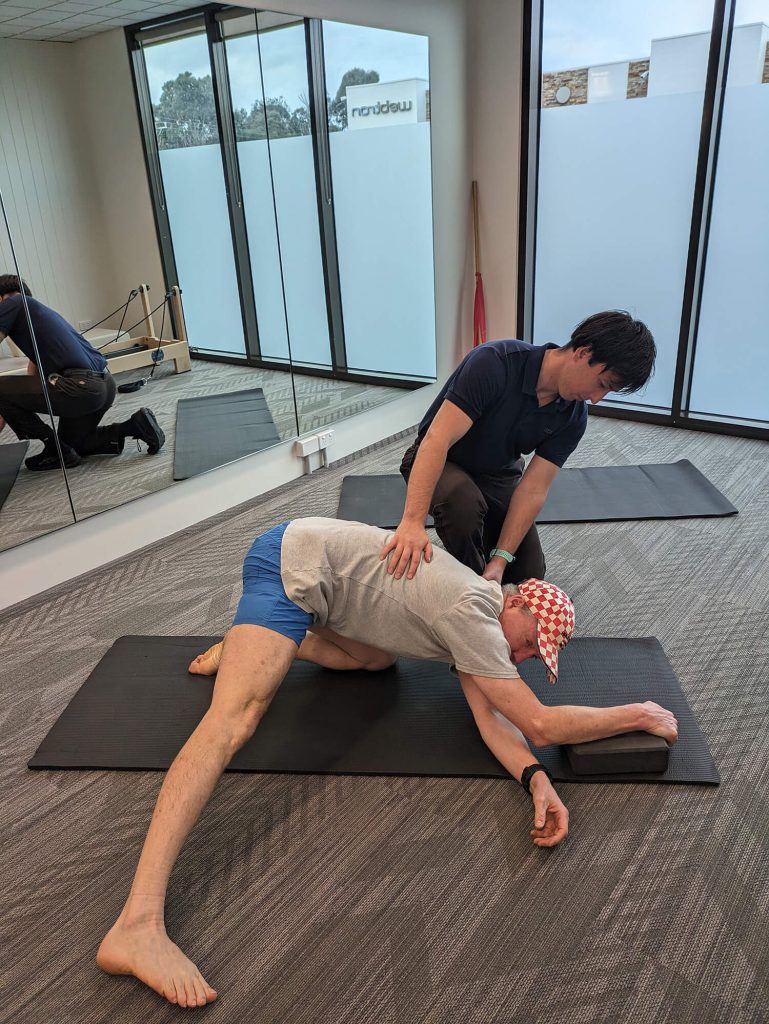Stretching is a crucial aspect of maintaining a healthy and active lifestyle. Whether you’re an athlete, a student, or someone who spends long hours at a desk, incorporating stretching into your daily routine can bring numerous benefits. In this blog, we’ll explore the role of stretching, different types of stretching techniques, the benefits of stretching for warm-up and cool-down, its relevance to sports and work, and how our physiotherapists can assist with stretching. We’ll also discuss the ideal duration and repetitions for effective stretching.
The Role of Stretching
Stretching is a form of physical exercise where a specific muscle or tendon is deliberately flexed or stretched to improve the muscle's elasticity and achieve comfortable muscle tone. The primary goal of stretching is to increase muscle control, flexibility, and range of motion. Regular stretching can help prevent injuries, reduce muscle soreness, and improve overall physical performance¹. By maintaining and improving flexibility, stretching ensures that our muscles and joints are in optimal condition, which is essential for performing everyday activities and engaging in various physical exercises. Stretching can be a key part of some of the treatments and rehabilitation we provide for people.

Types of Stretching
There are several types of stretching, each with its specific techniques and benefits. Let’s look at some of the most common ones:
1. Static Stretching
Static stretching involves holding a stretch in a challenging but comfortable position for a period of time, usually between 15 to 60 seconds². This type of stretching helps to increase flexibility and is often used as part of a cool-down routine after exercise. Static stretching is particularly beneficial because it allows the muscles to relax and lengthen gradually, reducing the risk of muscle strain.
Example: Touching your toes and holding the position for 30 seconds. This type of stretch targets the hamstrings, lower back, and calves, helping to improve flexibility in the posterior chain of the body.
2. Dynamic Stretching
Dynamic stretching involves moving parts of your body and gradually increasing reach, speed of movement, or both². It is controlled, smooth, and deliberate. Dynamic stretching is typically used as part of a warm-up routine to prepare the muscles for physical activity by increasing blood flow and muscle temperature.
Example: Arm circles or leg swings. These movements help to mobilise the joints and increase the range of motion, making dynamic stretching particularly useful before engaging in sports or high-intensity exercises.
3. Proprioceptive Neuromuscular Facilitation (PNF)
PNF stretching involves both stretching and contracting the muscle group being targeted. There are different techniques under PNF, including hold-relax and contract-relax. These techniques also act on the muscles' neural drive to be active or inactive. They are highly specific and are done with a clinician but can also be taught to you.
- Hold-Relax: The muscle is stretched to a comfortable limit and held in position. Then, the muscle is contracted without moving (isometrically) against resistance for about 5-10 seconds, followed by a deeper stretch³. This method helps to enhance muscle flexibility and strength by combining passive stretching and isometric contractions.
- Contract-Relax: The muscle is stretched to a comfortable limit, then contracted while moving (isotonic contraction) against resistance for about 5-10 seconds, followed by a deeper stretch³. This technique utilises the muscle's natural reflexes to achieve a greater stretch and improve overall flexibility.
Benefits of Stretching for Warm-Up and Cool-Down
Stretching plays a vital role in both the warm-up and cool-down phases of physical activity. Here’s how:
Warm-Up
- Increases Blood Flow: Stretching increases blood flow to the muscles, which helps to prepare them for the physical activity ahead⁴. Enhanced blood circulation ensures that the muscles receive an adequate supply of oxygen and nutrients, reducing the risk of injury.
- Improves Flexibility and Range of Motion: Dynamic stretching in particular helps to increase flexibility and range of motion, which can enhance performance and reduce the risk of injury². A proper warm-up that includes stretching can improve muscle function and efficiency during exercise.
- Prepares the Body Mentally: Warm-up stretching can help you focus and mentally prepare for the activity. This mental preparation is crucial for achieving optimal performance and maintaining concentration during physical activities.
Cool-Down
- Reduces Muscle Soreness: Stretching after exercise helps to reduce muscle soreness and stiffness by promoting blood circulation and removal of waste products like lactic acid⁴. This process aids in faster recovery and reduces the risk of muscle tightness and discomfort.
- Enhances Flexibility: Post-exercise stretching helps to maintain and improve flexibility². By stretching the muscles while they are still warm, you can enhance their elasticity and prevent stiffness.
- Promotes Relaxation: Stretching can have a calming effect, helping the body to relax and recover. This relaxation is essential for reducing stress and tension, contributing to overall well-being.
Stretching in Sports and Work
Sports
In sports, stretching is essential for optimal performance and injury prevention. Athletes incorporate stretching into their training routines to enhance flexibility, agility, and muscle coordination. For example, soccer players use dynamic stretches to prepare their muscles for quick sprints and sudden changes in direction, while gymnasts rely on static stretching to improve their flexibility for various routines. Stretching can also help athletes maintain peak performance levels by reducing muscle tightness and improving movement efficiency.
Work
For those who spend long hours at a desk, stretching is equally important. Prolonged sitting can lead to muscle stiffness, poor posture, and discomfort. Regular stretching breaks can alleviate these issues by improving blood flow, reducing muscle tension, and promoting better posture. Simple stretches like neck rolls, shoulder shrugs, and seated hamstring stretches can make a significant difference in overall well-being. Incorporating stretching into the workday can help prevent repetitive strain injuries and enhance productivity by keeping the body energised and alert.
How Physiotherapists Can Help
Physiotherapists are trained professionals who can help individuals improve their flexibility and muscle function through tailored stretching programs. They can:
- Assess Flexibility and Mobility: Our clinical team assesses an individual’s current flexibility and mobility to identify areas that need improvement. This assessment helps to create a personalised stretching plan that addresses specific needs and goals.
- Design Customised Stretching Programs: Based on the assessment, our clinicians design stretching routines that target specific muscle groups and address individual needs. These programs are tailored to help individuals achieve their desired level of flexibility and mobility.
- Assist with Stretching: Your treating clinician can perform assisted stretching, where they help move the limb into a stretch and hold it there. This can be especially useful for those recovering from an injury or surgery. Assisted stretching can enhance the effectiveness of the stretch and ensure it is performed safely.
- Educate on Proper Techniques: Our clinicians teach proper stretching techniques to ensure exercises are performed correctly and safely, maximising benefits and reducing the risk of injury. Proper technique is crucial for achieving optimal results and preventing strain or injury.
Ideal Duration and Repetitions for Stretching
To gain the maximum benefits from stretching, it’s important to follow proper guidelines for duration and repetitions. Here are some general recommendations:
- Static Stretching: Hold each stretch for 15-60 seconds and repeat 2-4 times⁴. Focus on deep, steady breathing to enhance relaxation. Consistent practice of static stretching can gradually improve flexibility and muscle tone.
- Dynamic Stretching: Perform each dynamic stretch for 10-15 repetitions, ensuring movements are controlled and not forced⁴. This approach prepares the muscles for physical activity by enhancing their readiness and range of motion.
- PNF Stretching: For hold-relax or contract-relax techniques, hold the initial stretch for 10 seconds, contract for 5-10 seconds, and then stretch further for 15-30 seconds. Repeat 2-4 times³. This method can be particularly effective for increasing muscle length and flexibility over time.
Conclusion
Incorporating stretching into your daily routine is essential for maintaining flexibility, preventing injuries, and improving overall physical performance. Whether you’re warming up for a sports event, cooling down after exercise, or trying to alleviate stiffness from prolonged sitting, stretching offers numerous benefits. Understanding the different types of stretching and following proper guidelines for duration and repetitions can help you make the most out of your stretching routine. Don’t forget to consult a physiotherapist if you need personalised advice or assistance with stretching. By prioritising stretching, you’re investing in your long-term health and well-being. Consistent practice and proper technique are key to reaping the full benefits of stretching, ensuring that you stay flexible, strong, and injury-free.










